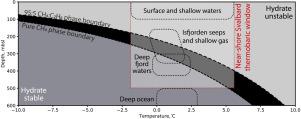Gas Science and Engineering Pub Date : 2021-07-09 , DOI: 10.1016/j.jngse.2021.104127 Peter Betlem 1, 2 , Srikumar Roy 3 , Thomas Birchall 1, 2 , Andrew Hodson 1, 4 , Riko Noormets 1 , Miriam Römer 5 , Ragnheid Skogseth 6 , Kim Senger 1

|
Large amounts of methane are trapped as natural gas hydrate (NGH) in the sediments of the Arctic. Unlike NGH provinces offshore west of Svalbard (Vestnesa Ridge), NGH potential in Svalbard’s fjords and near-shore environment is poorly constrained. In this study we modelled the NGH stability zone (GHSZ) to determine the NGH formation potential within the fjords of Svalbard. We applied a nearest neighbour interpolation method to dynamically derive statistical bottom-water temperature (BWT) trends from available CTD data. The BWT trends along with available geothermal gradient data constrained Svalbard-wide sub-bottom thermobaric models suitable for GHSZ modelling in the near subsurface. Analyses of source rock and fluid seepage data in Isfjorden, including 15 newly identified acoustic gas flares, indicate an active petroleum system with fluid migration reaching the seafloor with significant contributions of higher-order hydrocarbons to the gas feed. A GHSZ is predicted for most fjords at mean BWT conditions and 95:5 methane:ethane gas compositions. Suitable conditions for pure methane NGH formation are only met in the deepest parts of Isfjorden, Hinlopenstretet, Kross- and Kongsfjorden, and Rijpfjorden. Temporal constraints implemented along the well-defined Isfjorden transect indicated a notable negative response to water column warming. The predicted GHSZ across Svalbard’s fjords is likely to disappear over the next few decades.
中文翻译:

斯瓦尔巴群岛峡湾天然气水合物潜力的建模
大量甲烷作为天然气水合物 (NGH) 被困在北极的沉积物中。与斯瓦尔巴群岛(Vestnesa Ridge)以西近海的 NGH 省份不同,斯瓦尔巴群岛峡湾和近岸环境中的 NGH 潜力受到很大限制。在这项研究中,我们模拟了 NGH 稳定区 (GHSZ),以确定斯瓦尔巴群岛峡湾内的 NGH 形成潜力。我们应用最近邻插值法从可用 CTD 数据动态推导出统计底水温度 (BWT) 趋势。BWT 趋势以及可用的地热梯度数据限制了适用于近地下 GHSZ 建模的斯瓦尔巴群岛范围内的海底温压模型。Isfjorden 的烃源岩和流体渗流数据分析,包括 15 个新发现的声学气体耀斑,表明一个活跃的石油系统,流体运移到达海底,高阶碳氢化合物对气体进料有显着贡献。在平均 BWT 条件和 95:5 的甲烷:乙烷气体成分下,大多数峡湾预计会出现 GHSZ。只有在 Isfjorden、Hinlopenstretet、Kross- 和 Kongsfjorden 以及 Rijpfjorden 的最深处才能满足纯甲烷 NGH 形成的合适条件。沿明确定义的 Isfjorden 横断面实施的时间限制表明对水柱变暖的显着负面反应。在未来几十年中,斯瓦尔巴群岛峡湾中预测的 GHSZ 可能会消失。只有在 Isfjorden、Hinlopenstretet、Kross- 和 Kongsfjorden 以及 Rijpfjorden 的最深处才能满足纯甲烷 NGH 形成的合适条件。沿明确定义的 Isfjorden 横断面实施的时间限制表明对水柱变暖的显着负面反应。在未来几十年中,斯瓦尔巴群岛峡湾中预测的 GHSZ 可能会消失。只有在 Isfjorden、Hinlopenstretet、Kross- 和 Kongsfjorden 以及 Rijpfjorden 的最深处才能满足纯甲烷 NGH 形成的合适条件。沿明确定义的 Isfjorden 横断面实施的时间限制表明对水柱变暖的显着负面反应。在未来几十年中,斯瓦尔巴群岛峡湾中预测的 GHSZ 可能会消失。











































 京公网安备 11010802027423号
京公网安备 11010802027423号